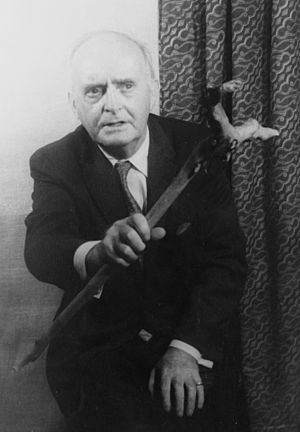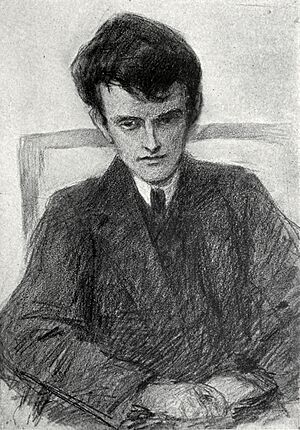Padraic Colum facts for kids
Quick facts for kids
Padraic Colum
|
|
|---|---|

Photographed by Carl Van Vechten, 1959.
|
|
| Born | Patrick Columb 8 December 1881 Columcille, County Longford, Ireland |
| Died | 11 January 1972 (aged 90) Enfield, Connecticut, United States |
| Nationality | Irish |
| Alma mater | University College Dublin |
| Period | 1902–58 |
| Notable works | The Saxon Shillin, The King of Ireland's Son |
| Spouse | Mary Maguire |
Padraic Colum (born December 8, 1881 – died January 11, 1972) was a famous Irish writer. He wrote many things, including poems, novels, and plays. He was also well-known for his children's books and for collecting old Irish folk stories. Padraic Colum was a key person in the Irish Literary Revival, a time when Irish writers celebrated their culture and traditions.
Contents
Growing Up in Ireland

Padraic Colum was born as Patrick Columb in a place called a workhouse in County Longford, Ireland. His father worked there. He was the first of eight children in his family.
In 1889, his father lost his job and went to the United States. He hoped to find gold in Colorado. Padraic, his mother, and his brothers and sisters stayed in Ireland. They lived with his grandmother in County Cavan.
When his father came back in 1892, the family moved to Glasthule, near Dublin. His father worked at a railway station there. Padraic went to the local school.
In 1897, Padraic's mother passed away. The family had to split up for a while. Padraic and one of his brothers stayed in Dublin. His father and the other children moved back to Longford.
Padraic finished school the next year. When he was 17, he passed an exam and got a job as a clerk. He worked for the Irish Railway Clearing House until 1903.
Starting His Writing Career
While working, Padraic Colum started writing. He met many important Irish writers of that time. These included W. B. Yeats, Lady Gregory, and Æ. He also joined the Gaelic League, which worked to protect Irish language and culture.
He was also part of the first group that started the Abbey Theatre. This theatre became very famous for Irish plays. Padraic often visited the National Library of Ireland. There, he became lifelong friends with another famous writer, James Joyce.
Padraic Colum received a special scholarship for five years. A rich American named Thomas Hughes Kelly helped him with this.
Early Plays and Poems
Padraic Colum won a prize for his play called The Saxon Shillin'. This play was against joining the army. He became very involved with the National Theatre Society. He helped to create the Abbey Theatre and wrote some of its first plays.
- His first play was Broken Soil (later called The Fiddler's House) in 1903.
- Another play, The Land (1905), was one of the Abbey Theatre's first big successes.
- He also wrote Thomas Muskerry (1910) for the Abbey.
His first poems were printed in a newspaper called The United Irishman. His first book of poems, Wild Earth (1907), was dedicated to Æ. One of his poems, The Poor Scholar, caught the attention of W.B. Yeats. Colum became good friends with Yeats and Lady Gregory.
Colum also collected and changed old Irish folk songs. He said he wrote most of the words for the famous song "She Moved Through the Fair".
In 1911, he helped start a short-lived magazine called The Irish Review. It published works by many leading writers of the time.
In 1912, Padraic married Mary Gunning Maguire. She was a student from University College Dublin. They both taught at special schools in Dublin. Padraic taught at Pádraig Pearse's school, Scoil Éanna. Mary taught at Scoil Íde, a girls' school.
The couple first lived in Donnybrook, Dublin. They often held literary gatherings there. Later, they moved to Howth, a small fishing village. In 1914, they traveled to the United States. They planned to stay for a few months, but they ended up living there for most of their lives.
Life and Work in America
In America, Padraic Colum started writing books for children. His first children's book was The King of Ireland's Son (1916). He began this book by translating an old Irish folk tale. He wanted to make sure he didn't forget the Irish language. An illustrator named Willy Pogany suggested they make it into a book. So, Colum turned the folk tale into a long, exciting story.
Three of his children's books later received special awards called the Newbery Honor. He signed a contract with Macmillan Publishers to write children's books. This made him financially secure for the rest of his life.
Some of his other famous children's books include:
- The Adventure of Odysseus (1918)
- The Children of Odin (1920)
These books were important because they helped bring classic stories to young readers.
In 1922, he was asked to write Hawaiian folk stories for young people. He published three books of these tales. The first book, At the Gateways of the Day, was even given to US President Barack Obama by the Irish leader in 2011.
Colum also started writing novels for adults. These included Castle Conquer (1923) and The Flying Swans (1937). From 1930 to 1933, the Colums lived in Paris and Nice, France. There, Padraic became friends again with James Joyce. He even helped Joyce by writing down parts of his famous book, Finnegans Wake.
After living in France, the couple moved to New York City. They taught at Columbia University and CCNY. Padraic Colum was a very busy writer. He published 61 books, not including his plays. He also wrote one screenplay for a stop-motion animated film called Hansel and Gretel in 1954.
Mary Colum passed away in 1957. Padraic finished a book they had worked on together, Our Friend James Joyce, which came out in 1958. In his later years, Colum spent his time between the United States and Ireland. He passed away in Enfield, Connecticut, at the age of 90. He was buried in St. Fintan's Cemetery, Sutton in Ireland.
In 1965, Colum sold his notes, writings, and letters to Binghamton University Libraries. He wanted to make sure that students and researchers could use his work to learn about Irish literature and history.
Selected Works
- (1902) The Saxon Shillin' (Play)
- (1903) Broken Sail (Play)
- (1905) The Land (Play)
- (1907) Wild Earth (Book of poems)
- (1907) The Fiddlers' House (Play)
- (1910) Thomas Muskerry (Play)
- (1916) The King of Ireland's Son (Irish Tales)
- (1918) The Children's Homer (Novel)
- (1918) The Boy Who Knew What The Birds Said
- (1920) The Boy Apprenticed to an Enchanter (Novel)
- (1920) Children of Odin: Nordic Gods and Heroes
- (1921) The Golden Fleece and the Heroes Who Lived Before Achilles (Novel)
- (1923) The Six Who Were Left in a Shoe (Children's Story)
- (1923) Castle Conquer (Novel)
- (1924) The Island of the Mighty: Being the Hero Stories of Celtic Britain Retold from the Mabinogion
- (1924) At the Gateways of the Day (Tales and legends of Hawaii)
- (1924) The Peep-Show Man
- (1925) The Bright Islands (Tales and legends of Hawaii V2)
- (1929) Balloon (Play)
- (1929) The Girl who Sat by the Ashes
- (1937) Legends of Hawaii
- (1937) The Story of Lowry Maen (Epic Poem)
- (1943) The Frenzied Prince (Irish Tales)
- (1957) The Flying Swans (Novel)
- (1958) Our Friend James Joyce (Memoir, with Mary Colum)
- (1963) Moytura: A Play for Dancers (Play)
As screenwriter:
- (1954) Hansel and Gretel
As editor:
- (1922) Anthology of Irish Verse
- (1923) The Arabian Nights: Tales of Wonder and Magnificence
- (1954) A Treasury of Irish Folklore: The Stories, Traditions, Legends, Humor, Wisdom, Ballads, and Songs of the Irish People
- (1964) Roofs of Gold: Poems to Read Aloud
Images for kids
See also
 In Spanish: Padraic Colum para niños
In Spanish: Padraic Colum para niños


